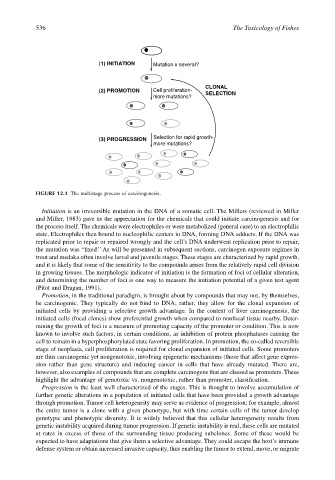Page 556 - The Toxicology of Fishes
P. 556
536 The Toxicology of Fishes
(1) INITIATION Mutation x several?
CLONAL
(2) PROMOTION Cell proliferation-
more mutations? SELECTION
Selection for rapid growth-
(3) PROGRESSION
more mutations?
FIGURE 12.1 The multistage process of carcinogenesis.
Initiation is an irreversible mutation in the DNA of a somatic cell. The Millers (reviewed in Miller
and Miller, 1983) gave us the appreciation for the chemicals that could initiate carcinogenesis and for
the process itself. The chemicals were electrophiles or were metabolized (general case) to an electrophilic
state. Electrophiles then bound to nucleophilic centers in DNA, forming DNA adducts. If the DNA was
replicated prior to repair or repaired wrongly and the cell’s DNA underwent replication prior to repair,
the mutation was “fixed.” As will be presented in subsequent sections, carcinogen exposure regimes in
trout and medaka often involve larval and juvenile stages. These stages are characterized by rapid growth,
and it is likely that some of the sensitivity to the compounds arises from the relatively rapid cell division
in growing tissues. The morphologic indicator of initiation is the formation of foci of cellular alteration,
and determining the number of foci is one way to measure the initiation potential of a given test agent
(Pitot and Dragan, 1991).
Promotion, in the traditional paradigm, is brought about by compounds that may not, by themselves,
be carcinogenic. They typically do not bind to DNA; rather, they allow for the clonal expansion of
initiated cells by providing a selective growth advantage. In the context of liver carcinogenesis, the
initiated cells (focal clones) show preferential growth when compared to nonfocal tissue nearby. Deter-
mining the growth of foci is a measure of promoting capacity of the promoter or condition. This is now
known to involve such factors, in certain conditions, as inhibition of protein phosphatases causing the
cell to remain in a hyperphosphorylated state favoring proliferation. In promotion, the so-called reversible
stage of neoplasia, cell proliferation is required for clonal expansion of initiated cells. Some promoters
are thus carcinogenic yet nongenotoxic, involving epigenetic mechanisms (those that affect gene expres-
sion rather than gene structure) and inducing cancer in cells that have already mutated. There are,
however, also examples of compounds that are complete carcinogens that are classed as promoters. These
highlight the advantage of genotoxic vs. nongenotoxic, rather than promoter, classification.
Progression is the least well characterized of the stages. This is thought to involve accumulation of
further genetic alterations in a population of initiated cells that have been provided a growth advantage
through promotion. Tumor cell heterogeneity may serve as evidence of progression; for example, almost
the entire tumor is a clone with a given phenotype, but with time certain cells of the tumor develop
genotypic and phenotypic diversity. It is widely believed that this cellular heterogeneity results from
genetic instability acquired during tumor progression. If genetic instability is real, these cells are mutated
at rates in excess of those of the surrounding tissue producing subclones. Some of these would be
expected to have adaptations that give them a selective advantage. They could escape the host’s immune
defense system or obtain increased invasive capacity, thus enabling the tumor to extend, move, or migrate

